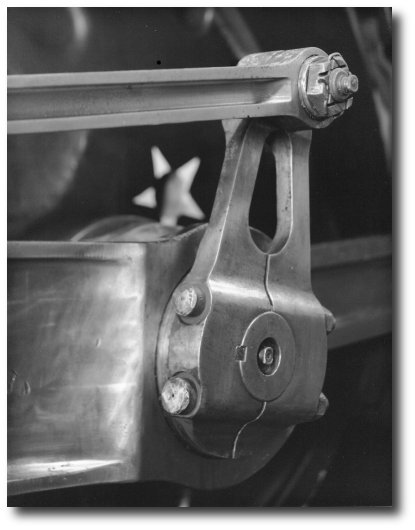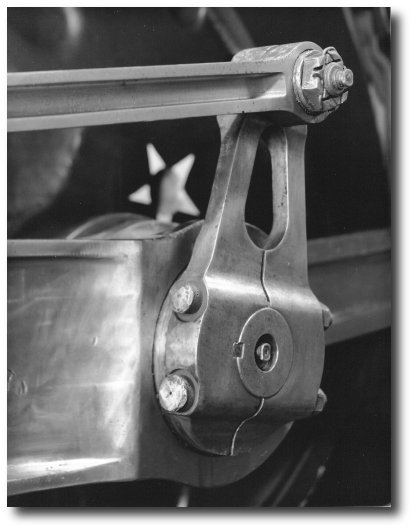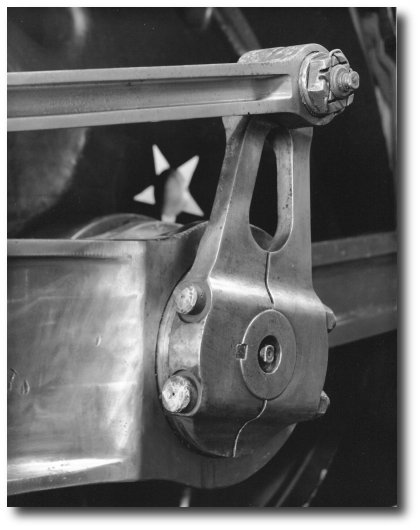
- 150mm Germinar-W f/9
300mm APO Germinar f/9
240mm Geraminar W f/9
210mm Docter Tessar f/4.5
| Home |
| Last update: 03 March, 2006 |
Docter Optics Germinar and Tessar lenses

|
From left to right:
300mm APO Germinar f/9 240mm Geraminar W f/9 210mm Docter Tessar f/4.5 |
In the photographic world, famous optical companies abound. Years ago it was Kodak with their much vaunted and still incredibly sharp Commercial Ektar series. In modern times companies like Schneider, Rodenstock, Fuji, and Nikon are well known and widely used by photographers who use large cameras. Lesser known manufacturers include Wollensak, Zeiss, Voigtlaender, Bausch and Lomb, and many many others. And then there are lens manufacturers practically no one has ever heard of. Docter Optics was one of these manufacturers.
Through the very kind knowledge and leadership of Kerry Thalmann, I have come to own four incredible Docter Optics lenses. They are the 150mm Germinar-W f/9, the 210mm Tessar f/4.5, the 240mm Germinar-W f/9, and the 300mm APO Germinar f/9 lenses.
History
Arne Croell has written about Large format lenses from Docter Optic. He has studied these interesting lenses over the years and has been published in places like View Camera magazine discussing the topic. For more information it's worth reading his materials.
Kerry has also written about Docter Optic lenses. Here is what he says.
OK, fast forward to the reunification of Germany in the early 1990s. After the reunification the assets of state owned companies, such as VEB Carl Zeiss Jena, were sold to the highest bidder. Since VEB Carl Zeiss Jena was a very large and diverse company, it was sold off in pieces. The division that made large format lenses was bought by an optical designer of some renown, Bernhard Docter and renamed Docter Optics, Inc. Docter Optics continued to make Zeiss classic designs, such as the Tessar and APO Germinar, but adapted them mechanically to fit into standard Copal shutters.
Now the unfortunate part. Right as Docter Optics was ramping up production and becoming a legitimate supplier of fine large format lenses, Bernhard Docter passed away. After Herr Docter's untimely death, his company, Docter Optics, plunged into bankruptcy. This was truly a loss to the large format community. It would have been wonderful to see what new lens designs Docter Optics could have produced under the guidance of such a talented man (Bernhard Docter was a pioneer in the area of aspheric lens manufacturing techniques). Docter Optics was again split into parts and the divisions sold off. Unfortunately, the company that bought the division that made large format lenses had no intention of continuing to produce the Docter Optics large format lens lines. They immediately discontinued production of all Docter Optics large format lenses, and eventually scrapped existing inventory. How unfortunate, but that's the way big business operates.
Some of you may be familiar with the name Docter Optics, but I suspect many of you are not. I'm sure most of you are familiar with the Zeiss name. So, I'll start there. Following WWII Zeiss, which was located in the East German city of Jena, was split into two different companies with similar names. The East German Carl Zeiss, known as VEB Carl Zeiss Jena, under the control of the East German government and the West German Carl Zeiss in a newly built plant in Oberkochen. Of course, the West German Carl Zeiss in Oberkochen became famous as the maker of lenses for such medium format SLRs as Hasselblad and Rollei. The East German Carl Zeiss became the primary supplier of high end medium and large format lenses to the Eastern Block communist countries. They continued to make such classic designs as the Zeiss Tessar in a wide variety of focal lengths. Although many cameras manufactured in the former Eastern Block nations often suffer from poor reliability and inconsistent quality control, the same is not necessarily true of lenses from these countries - especially lenses made by VEB Carl Zeiss Jena. In fact, these lenses are still sought out by many photographers for their quality construction and excellent optical performance.
150mm Germinar-W f/9
My lens is mounted in a Seiko #0 shutter. Configured in this way, the lens is extremely light at 135grams. Mounted in a nice Compur shutter would bring the weight down to 130grams (the same as an old Schneider 90mm Angulon f/6.8). It is by far the smallest modern multi-coated lens that I know of in 150mm's that covers 4x5 or 5x7. Mine is particularly sharp.
Kerry continues...
The 150mm f9 Germinar W is a multicoated lens of plasmat construction (6 elements in 4 groups). The design is very similar to the Schneider G Claron and the highly regarded Fujinon A series. Like the Fujinon A, coverage at f22 is 70 degrees. This yields an image circle of about 210mm at f22. This is enough coverage for 4x5 with room left over for movements, or enough to just hit the corners of 5x7 without movements. Like the G Claron, usable coverage continues to increase as you stop down further. The circle of illumination is much larger than the circle of sharp definition. Significant movements, with good corner-to-corner sharpness can be realized on the 5x7 format by stopping down to f32 or f45. Like the 150mm G Claron, this makes the 150mm Germinar W and great lens for 4x5 or even 5x7 landscape photography. Like the G Claron, The 150mm Germinar W is quite compact and lightweight for a lens capable of covering the 5x7 format. In fact, it's the smallest, ligtest multicoated lens ever made capable of covering 4x5 or 5x7. The filter size is 35.5mm and the weight in the original barrel is about 150g. Like the G Claron, the 150mm Germinar W directly fits into a standard No. 0 shutter (Copal, Compur, Prontor or Seiko). In a Compur 0 shutter, as shown below, the weight is an unbelievable 132g. I know of no other multicoated, shutter mounted lens this light capable of covering 4x5, let alone 5x7. This makes the 150mm Germinar W the backpacker's dream lens.
240mm Germinar-W f/9
I just picked up one of these lenses. It appears to be as small and light as Schneider's 240mm GClaron. I an anxious to try this lens for two reasons. First, it comes multicoated (which is something Schneider never did with their GClaron lenses). Second, I mounted this lens in a #1 Prontor shutter that came with a multi-blade aperture. The aperture opening is nearly perfectly round. If there are any effects on the out of focus areas due to the shape of the aperture, perhaps I will see some benefit from using this lens in the Prontor shutter. I'm also excited to try this lens as I might make a good companion when traveling overseas. It might be a replacement for the 200Nikkor and 300Nikkor combination. 240mm might "split" the difference nicely, and keep the lens kit weight to a minimum.
Kerry continues...
Docter Optic 210mm f/4.5 Tessar
This has got to be the craziest lens in my kit. It's a 210mm lens mounted in a huge #3 Copal shutter. The lens barrels themselves are not all that large. Docter Optic also made a 180mm Tessar lens that too was mounted in a #3 shutter. It's wonderful overkill for a Tessar. Most modern 210mm lenses come mounted in #1 shutters. Schneider's huge 210mm Super Symmar Xl is the exception. It too comes mounted in a #3 shutter. The other exception is Nikon's wonderously small 200mm M f/8. It comes in a #0 shutter. Perhaps Docter Optics needed a "clear" light path for their large aperture Tessar? This may be the case as Schneider's 210mm Xenar is limited to f/6.1 and is mounted in a #1 shutter.
Kerry continues...

|

|

|
| 210mm Docter Tessar f/4.5, 1/2 sec, TMax100 | 210mm Docter Tessar f/5.6, 1 sec, TMax100 | 210mm Docter Tessar f/8, 2 sec, TMax100 |
These images were taken to prove to myself just how sharp this lens could be at wider apertures. While the image at f/4.5 appears a little soft due to the lack of depth of field, there is nothing preventing me from using the Docter Optic 210mm Tessar f/4.5 lens for selective focus images. The resolution and contrast of the lens at f/4.5 is simply amazing. At f/5.6 this lens is as sharp and contrasty as anything I have ever personally used. I don't know what else to say, but I'm pleasantly shocked at the performance of this lens!
300mm APO Germinar f/9
The 300mm APO Germinar is very small and very light. It is lighter than a 300mm Nikkor. Mine is mounted in yet another round aperture Prontor #1 shutter. In use, this is one of my sharpest most contrasty lenses. Surprisingly it is only single coated.
Kerry continues...
How many of these in existance?
Reliable sources tell me that perhaps less than 40 300mm APO Germinar f/9 lenses are in existance. Less than 90 240mm Germinar-W f/9 lenses may exist. Less than 60 150mm Germinar-W f/9 may have survived the Docter Optic buy-out. I don't know how many 210mm Tessar f/4.5 lenses exist. But if it's any indication, a 180mm f/4.5 mounted in Copal #3 shutter turned up on eBay recently. However this all shakes out, very very few of the marvelous lenses escaped into the wilds to be used as regular photographic optics. In a way, the small number of examples are a crime against humanity. Or at least against nutter photographers. Docter Optics appeared ready to deliver lenses to large format practioners in areas not already covered by the competition. It's sad that we will never know how well these fine lenses would have been received.
Email if interested in providing comments or feedback: Christopher Perez